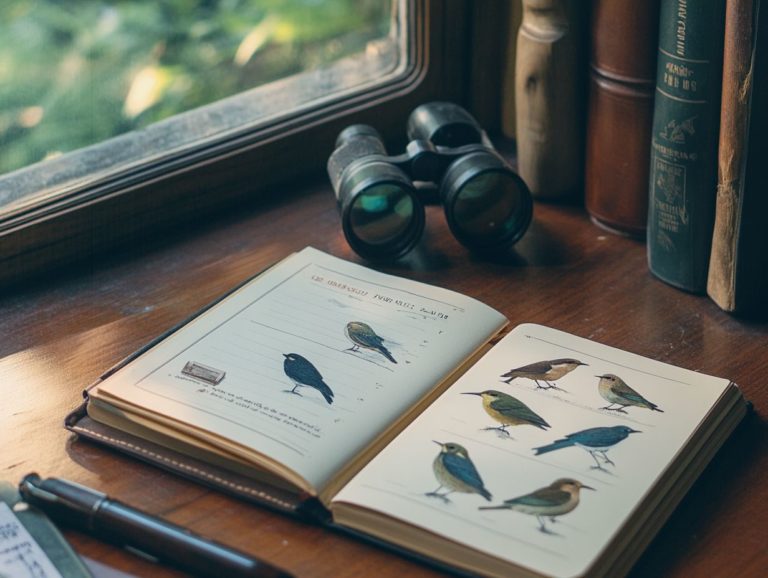The Role of Illustrations in Bird Field Guides
Bird field guides are invaluable tools for you, offering deep insights into the captivating world of avian species.
While photographs can capture fleeting moments, illustrations bring a level of clarity and detail that is essential for accurate identification. This article delves into the significance of bird field guides, highlighting the advantages of illustrations and the diverse types employed in these resources.
Get ready to dive into the exciting art and science of bird identification!
Contents
- Discover the Key Insights:
- The Importance of Bird Field Guides
- The Role of Illustrations in Bird Field Guides
- Types of Illustrations Used in Bird Field Guides
- Creating Effective Illustrations for Bird Field Guides
- The Evolution of Illustrations in Bird Field Guides
- Frequently Asked Questions
- 1. What is the role of illustrations in bird field guides?
- 2. Can illustrations in bird field guides be used as the sole means of bird identification?
- 3. What makes illustrations in bird field guides unique compared to photographs?
- 4. Are all illustrations in bird field guides drawn from real birds?
- 5. How Can Illustrations in Bird Field Guides Help Beginners in Birdwatching?
- 6. Limitations of Illustrations in Bird Field Guides
Discover the Key Insights:
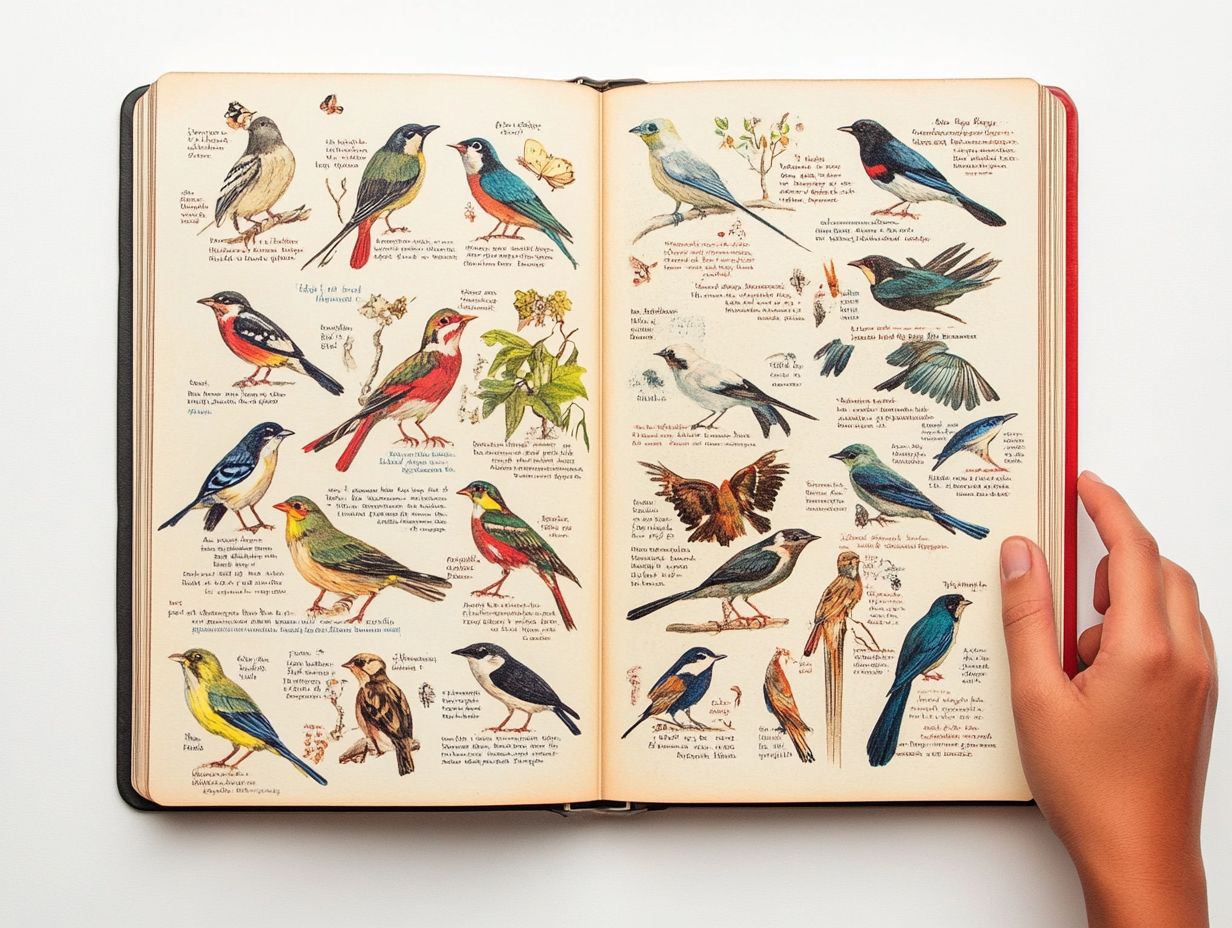
- Illustrations are vital in bird field guides, making identification clear and accurate!
- Compared to photographs, illustrations offer flexibility in showcasing key features while removing distracting backgrounds.
- Realistic and stylized illustrations are common types in bird field guides, each serving different purposes.
The Importance of Bird Field Guides
Bird field guides are essential tools for anyone, whether you’re just starting out or you re an experienced birder. They provide crucial information for identifying birds through various methods, including visual identification and descriptions of how birds act.
These guides enhance your naturalist skills by detailing the specific identification of local species and their seasonal variations. They are invaluable resources for backyard birding enthusiasts and serious ornithologists alike.
Guides like the Peterson Field Guide can significantly elevate your knowledge and enjoyment of birdwatching. They offer a wealth of information on field marks and range maps that aid in the identification process.
Why Bird Field Guides are Essential for Birders
Bird field guides are your companions on the birding journey, providing insights for identifying various species and enhancing your birdwatching experience. They equip you with the knowledge needed to recognize local birds, transforming each outing into an engaging adventure.
These guides also serve as gateways into the fascinating world of avian life. They reveal intricate behaviors, habitats, and seasonal patterns. By streamlining the identification process, bird field guides empower you to forge a deeper connection with nature.
As you explore new areas, these guides enrich your understanding of the diverse local species you may encounter, turning casual observations into valuable learning experiences.
Using a field guide not only hones your naturalist skills but also encourages you to appreciate the ecological roles that birds play within their environments. This fosters a more sustainable relationship with local ecosystems.
The Role of Illustrations in Bird Field Guides
Illustrations in bird field guides are essential for effective visual identification. They help you distinguish between species by highlighting detailed field marks and providing descriptions that enhance your identification experience, making understanding bird identification with field guides invaluable for enthusiasts.
Advantages of Illustrations over Photographs
Illustrations often provide distinct advantages over photographs in bird field guides. They allow you to focus on specific field marks crucial for visual identification without the distractions typical of photographic images.
Consider the various lighting conditions and angles from which photographs are captured; these factors can easily obscure vital details. In contrast, skilled artists create illustrations that emphasize distinguishing features like plumage color, beak shape, and wing patterns. This ensures even the subtlest differences are clear.
Illustrations can present birds in idealized poses or environments, making the identification process more straightforward and accessible for you as a birdwatcher. By honing in on critical characteristics often overlooked in photographs illustrative representations significantly enhance your ability to make accurate identifications in the field.
Grab your field guide and step outside the birds are waiting for you!
How Illustrations Contribute to Identification
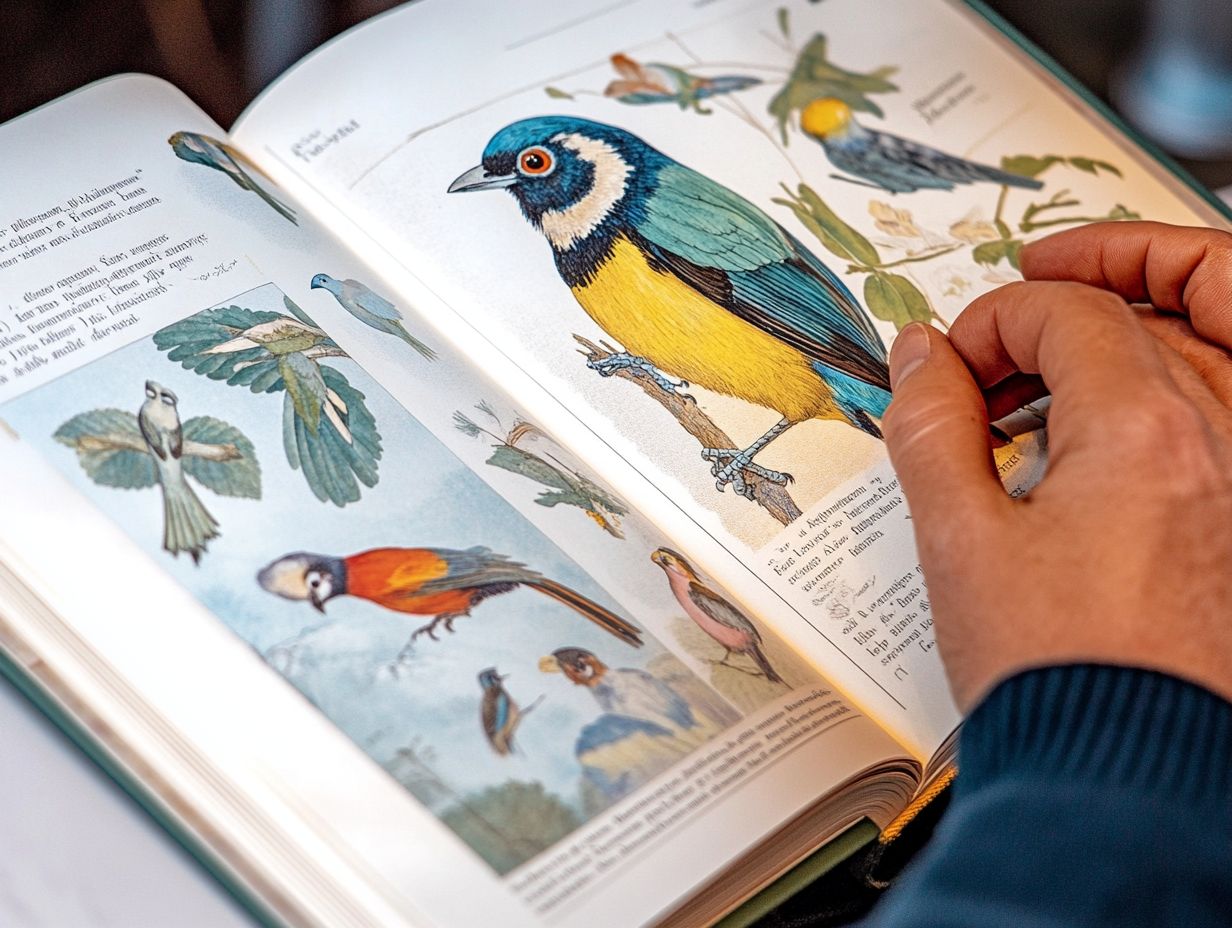
Illustrations play a crucial role in bird identification by offering clear representations of field marks and behavioral descriptions. Understanding the top features to look for in a bird field guide is vital for your visual identification efforts and for distinguishing between closely related species.
These visual aids empower both enthusiasts and ornithologists to recognize subtle differences in feathers, shape, and size that might easily slip past you in photographs or written descriptions alone. By highlighting unique characteristics, such as bill shape and wing patterns, illustrations bridge the gap between what you see and what you understand, allowing you to visualize essential features with greater clarity.
These illustrations show birds in different postures or habitats, providing valuable context for their behaviors and adaptations to various environments. This approach makes identifying birds easier and more exciting!
Types of Illustrations Used in Bird Field Guides
Bird field guides feature a diverse array of illustrations, blending realistic and stylized representations to cater to your unique preferences for visual identification. This thoughtful design enriches your experience and elevates the process of identifying birds, making it both enjoyable and effective.
Realistic Illustrations
Realistic illustrations in bird field guides are crafted to depict birds with remarkable accuracy, emphasizing essential field marks that facilitate identification. Each illustration reflects meticulous attention to detail and anatomical correctness.
These images do more than merely capture the distinctive features of various species; they reveal the subtle variations that set one bird apart from another. For the enthusiast, a well-executed image can illuminate critical aspects such as feather color, the shape of the beak, and the size of the wings elements vital for precise identification.
Incorporating relevant context, like the bird s natural habitat, enhances your understanding and sharpens your observational skills. Accurate portrayals that spotlight these field marks enrich your birdwatching experience, ultimately allowing you to cultivate a deeper appreciation for the remarkable diversity of avian life.
Stylized Illustrations
Stylized illustrations in bird field guides harness artistic creativity to depict birds, providing you with a unique lens for visual identification while still highlighting essential features critical for recognizing different species.
These illustrations are different from regular photos, enticing both casual observers and dedicated ornithologists alike. By incorporating vibrant colors and imaginative styling, the illustrations not only capture the essence of each species but also evoke a sense of wonder and appreciation for avian diversity.
This artistic approach deepens your connection with nature, making it easier for you to spot distinctive traits like feather patterns and beak shapes. These illustrations seamlessly blend aesthetics with practicality, ensuring that the information remains accessible and enriching serving as a bridge between art and science in the enchanting realm of birdwatching.
Creating Effective Illustrations for Bird Field Guides
Crafting effective illustrations for bird field guides requires a good mix of artistic techniques and a deep understanding of bird anatomy, behavior, and field marks. This knowledge not only aids in accurate bird identification but also enriches your naturalist skills, allowing you to truly appreciate the beauty of avian life.
So grab your field guide and start exploring the amazing world of birds today!
Techniques and Considerations
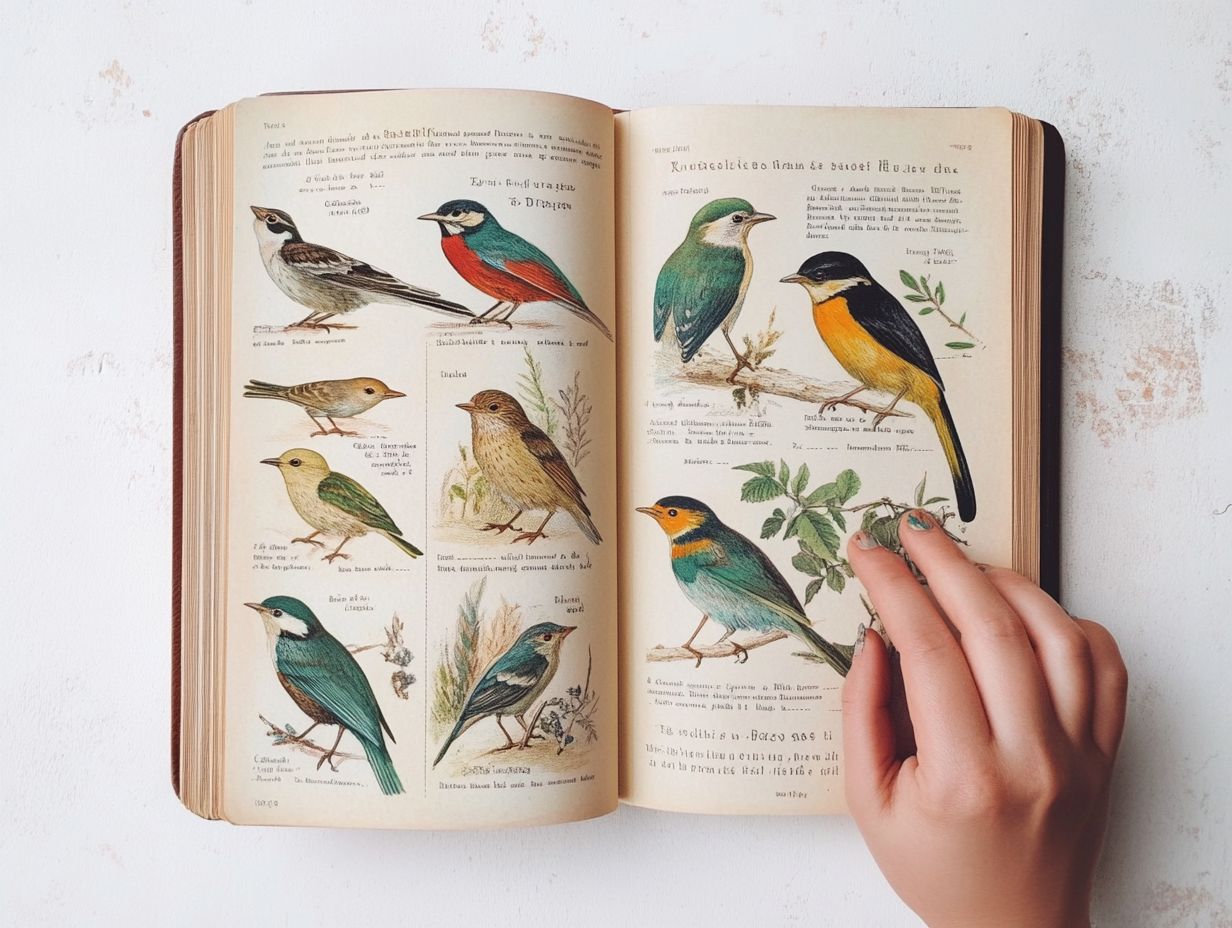
Creating bird illustrations requires careful focus on accuracy and detail. This ensures that crucial field marks are clearly depicted to aid in effective bird identification.
Artists and illustrators employ a range of techniques to achieve this level of precision. They often start with field studies to observe birds in their natural habitats. This hands-on experience allows them to note essential features such as plumage color, wing shape, and distinct markings.
Many artists also leverage photography as a reference tool, capturing these avian subjects from multiple angles.
With the rise of specialized digital tools and software, you can refine your illustrations even further. Integrating these practices elevates the visual appeal of your work and enhances a birdwatcher’s ability to differentiated between similar species in the field.
The Evolution of Illustrations in Bird Field Guides
The evolution of illustrations in bird field guides showcases a fascinating tapestry woven from artistic flair and scientific progress.
This journey demonstrates how visual styles and accuracy have transformed over time. It thoughtfully addresses the evolving needs of birders and naturalists.
Appreciating the intricate relationship between art and science enhances your understanding and enjoyment of the avian world.
Historical Development and Changes Over Time
The historical development of bird illustrations in field guides reveals a captivating evolution.
This evolution is shaped by artistic trends and scientific breakthroughs. It leads to more refined techniques that enhance your ability to identify birds.
Over the centuries, numerous artists and ornithologists have expanded the boundaries of avian depiction. They skillfully merge realistic portrayals with meticulous anatomical accuracy.
The advent of technologies like lithography and digital printing allowed for vibrant colors and intricate details that highlight the unique features of each bird.
This exciting evolution has turned field guides into critical resources for birdwatchers, deepening your connection to the natural world.
As illustrated field guides have become more accessible and visually striking, they empower you to identify species with newfound confidence and enthusiasm. This enriches your experience of observing these remarkable creatures.
Frequently Asked Questions
1. What is the role of illustrations in bird field guides?
The role of illustrations in bird field guides is to visually represent the physical characteristics and identifying features of different bird species. For those interested in this hobby, understanding the layout of bird field guides allows birdwatchers and bird enthusiasts to easily identify and differentiate between various birds in the wild.
2. Can illustrations in bird field guides be used as the sole means of bird identification?
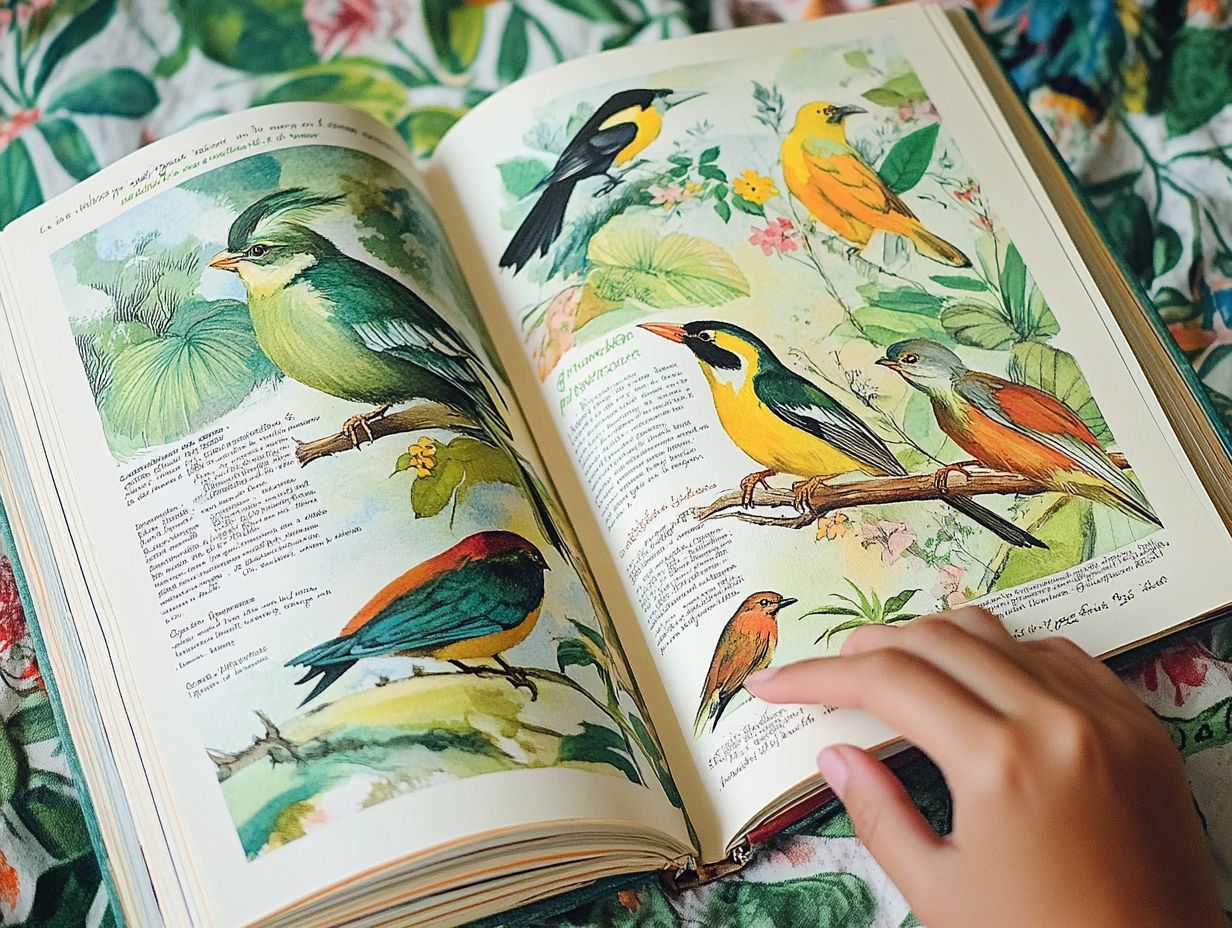
No, illustrations should not be the only means of bird identification in field guides. They should be used in conjunction with written descriptions, range maps, and other identification tools to ensure accurate identification of bird species.
3. What makes illustrations in bird field guides unique compared to photographs?
Illustrations in bird field guides are unique because they are often hand-drawn by skilled artists. They can capture the unique features and characteristics of each bird species. This allows for a more detailed and accurate representation of the birds compared to photographs, which may have limitations in capturing certain details.
4. Are all illustrations in bird field guides drawn from real birds?
While most illustrations in bird field guides are drawn from real birds, some may be based on the artist’s interpretation or a combination of multiple bird sightings. It is important to note that these illustrations are still accurate representations of the bird species.
5. How Can Illustrations in Bird Field Guides Help Beginners in Birdwatching?
Illustrations in bird field guides are invaluable for beginners. They provide a clear visual aid for identifying various bird species.
These detailed illustrations help users recognize physical characteristics and key features of each bird.
6. Limitations of Illustrations in Bird Field Guides
One limitation of illustrations is that they might not accurately represent the size of a bird compared to how it looks in photographs. This discrepancy can make it difficult to identify birds in the field.
Also, illustrations can differ slightly between guides. Always choose a reliable source to ensure you have accurate information.



